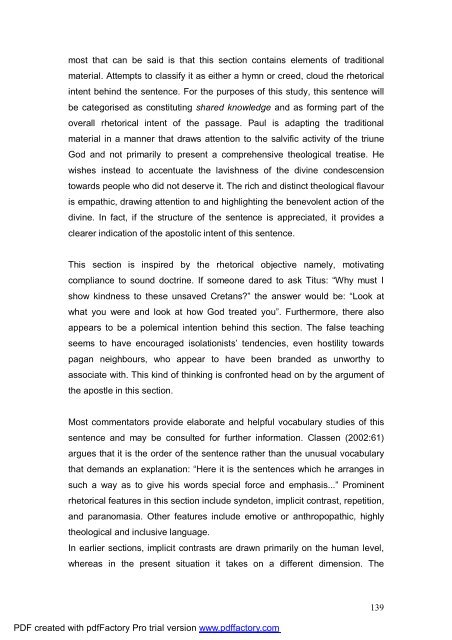A Text centred rhetorical analysis of Paul's Letter to Titus
A Text centred rhetorical analysis of Paul's Letter to Titus
A Text centred rhetorical analysis of Paul's Letter to Titus
You also want an ePaper? Increase the reach of your titles
YUMPU automatically turns print PDFs into web optimized ePapers that Google loves.
most that can be said is that this section contains elements <strong>of</strong> traditional<br />
material. Attempts <strong>to</strong> classify it as either a hymn or creed, cloud the <strong>rhe<strong>to</strong>rical</strong><br />
intent behind the sentence. For the purposes <strong>of</strong> this study, this sentence will<br />
be categorised as constituting shared knowledge and as forming part <strong>of</strong> the<br />
overall <strong>rhe<strong>to</strong>rical</strong> intent <strong>of</strong> the passage. Paul is adapting the traditional<br />
material in a manner that draws attention <strong>to</strong> the salvific activity <strong>of</strong> the triune<br />
God and not primarily <strong>to</strong> present a comprehensive theological treatise. He<br />
wishes instead <strong>to</strong> accentuate the lavishness <strong>of</strong> the divine condescension<br />
<strong>to</strong>wards people who did not deserve it. The rich and distinct theological flavour<br />
is empathic, drawing attention <strong>to</strong> and highlighting the benevolent action <strong>of</strong> the<br />
divine. In fact, if the structure <strong>of</strong> the sentence is appreciated, it provides a<br />
clearer indication <strong>of</strong> the apos<strong>to</strong>lic intent <strong>of</strong> this sentence.<br />
This section is inspired by the <strong>rhe<strong>to</strong>rical</strong> objective namely, motivating<br />
compliance <strong>to</strong> sound doctrine. If someone dared <strong>to</strong> ask <strong>Titus</strong>: “Why must I<br />
show kindness <strong>to</strong> these unsaved Cretans?” the answer would be: “Look at<br />
what you were and look at how God treated you”. Furthermore, there also<br />
appears <strong>to</strong> be a polemical intention behind this section. The false teaching<br />
seems <strong>to</strong> have encouraged isolationists’ tendencies, even hostility <strong>to</strong>wards<br />
pagan neighbours, who appear <strong>to</strong> have been branded as unworthy <strong>to</strong><br />
associate with. This kind <strong>of</strong> thinking is confronted head on by the argument <strong>of</strong><br />
the apostle in this section.<br />
Most commenta<strong>to</strong>rs provide elaborate and helpful vocabulary studies <strong>of</strong> this<br />
sentence and may be consulted for further information. Classen (2002:61)<br />
argues that it is the order <strong>of</strong> the sentence rather than the unusual vocabulary<br />
that demands an explanation: “Here it is the sentences which he arranges in<br />
such a way as <strong>to</strong> give his words special force and emphasis...” Prominent<br />
<strong>rhe<strong>to</strong>rical</strong> features in this section include synde<strong>to</strong>n, implicit contrast, repetition,<br />
and paranomasia. Other features include emotive or anthropopathic, highly<br />
theological and inclusive language.<br />
In earlier sections, implicit contrasts are drawn primarily on the human level,<br />
whereas in the present situation it takes on a different dimension. The<br />
PDF created with pdfFac<strong>to</strong>ry Pro trial version www.pdffac<strong>to</strong>ry.com<br />
139

















